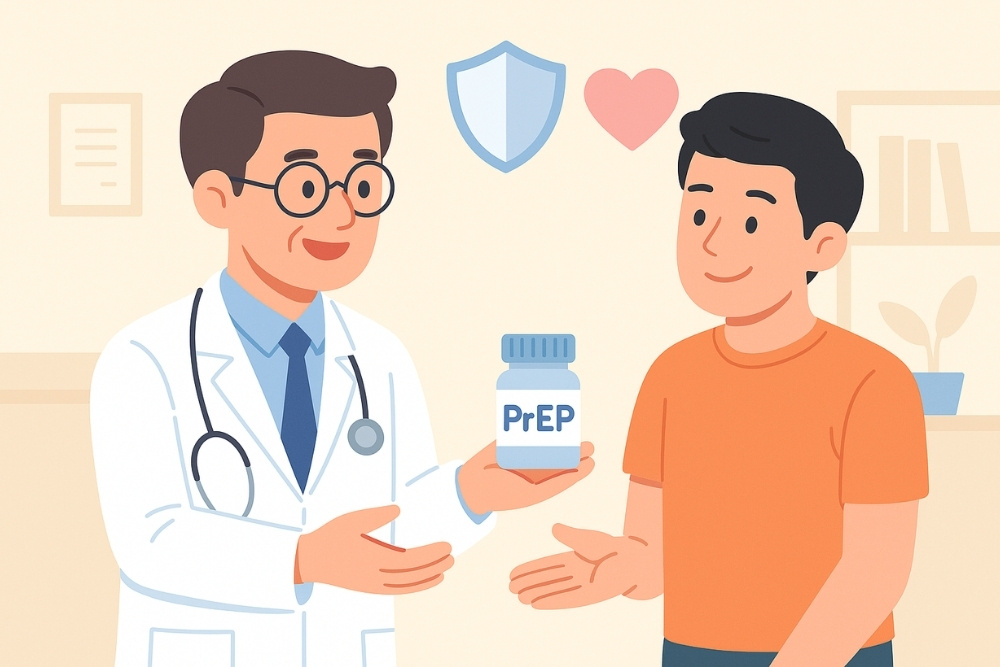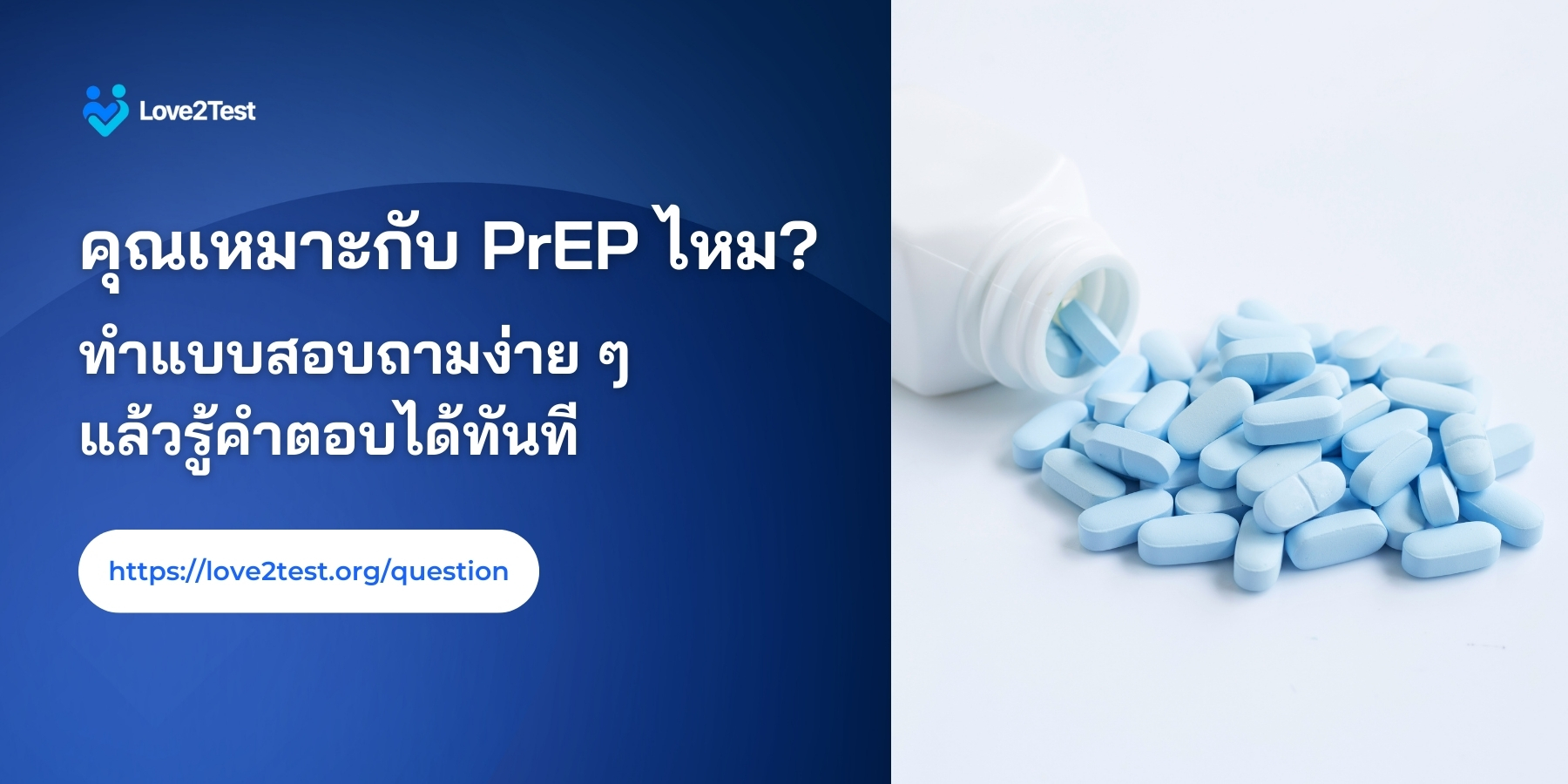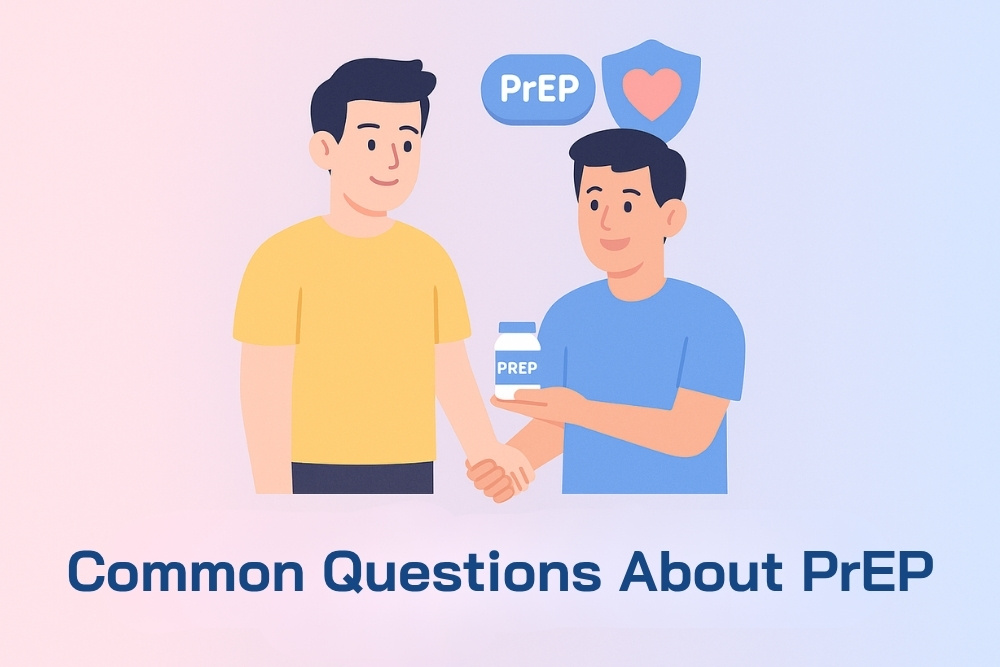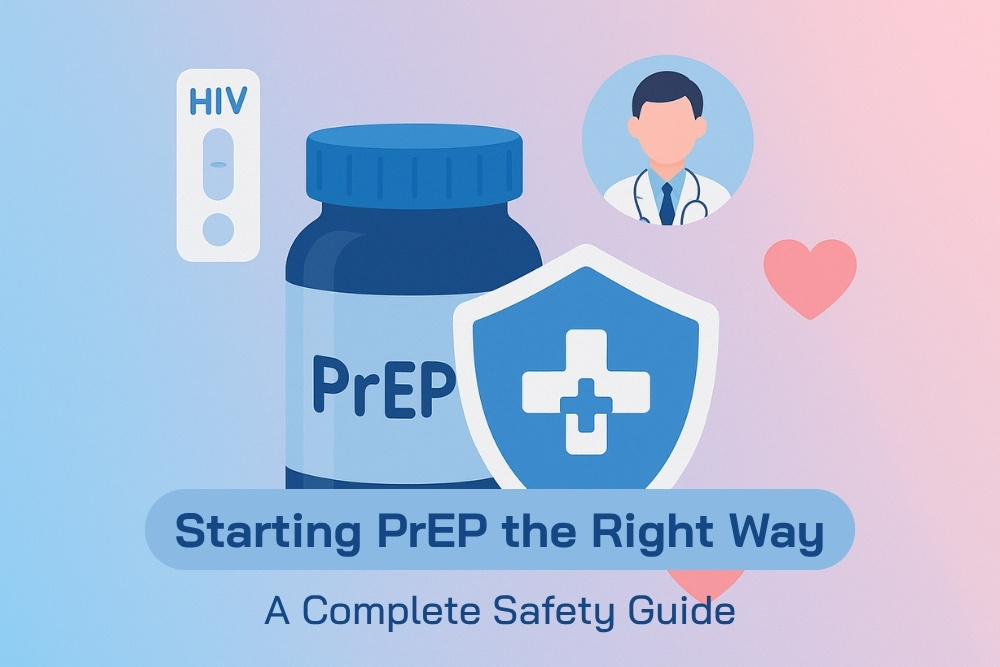Starting PrEP is one of the most modern and highly effective innovations in HIV prevention today. The principle is simple: if your body consistently maintains an adequate level of PrEP medication, it can significantly reduce the risk of HIV infection. This is especially important for people at higher risk, including those with multiple sexual partners, individuals whose partners are living with HIV, or anyone who wants to ensure confidence and safety in every sexual encounter.
While the idea of starting PrEP may sound complicated for beginners, the truth is that it’s not as difficult as it seems once you understand the right approach. This article serves as a beginner’s guide to PrEP—covering how to take it safely, how to make it truly effective, and answering all the most common concerns. From how to get started, possible side effects, necessary health check-ups, to clearing up misconceptions about PrEP, you’ll find practical and reliable guidance here. If you’ve ever asked yourself, “Should I start taking PrEP now?” or “What kind of self-care is required while on PrEP?” this guide will provide the answers you need—helping you begin your HIV prevention journey with confidence, safety, and peace of mind.
Why Starting PrEP Is the Key to Stopping HIV
PrEP (Pre-Exposure Prophylaxis) is one of the most effective strategies available today for HIV prevention. The reason it is often called a “key” is not only because research has confirmed that it reduces the risk of infection by more than 90%, but also because PrEP helps close the gaps left by traditional prevention methods that may have certain limitations.

- Reducing the risk among high-risk groups
- Whether it’s MSM (men who have sex with men), serodiscordant couples, individuals with multiple sexual partners, or those who cannot always use condoms consistently, taking PrEP significantly lowers the risk of HIV infection. It serves as an “extra shield,” strengthening protection.
- Filling the gaps of other prevention methods
- Condoms remain an essential tool, but in real life they can break, slip, or simply not be used every time. Having PrEP alongside condoms increases protection and reduces the risks that come from unintentional mistakes.
-
Building psychological confidence
- Many people who start PrEP often say their “life has changed,” as they no longer have to live with constant fear or worry after sex. This sense of confidence improves overall quality of life and helps reduce guilt or stress often associated with sexual activity.
- A proactive step that helps reduce transmission in society
- Taking PrEP not only protects you but also plays a role in lowering HIV transmission rates at the community level. The more people who use PrEP, the fewer new infections will occur. This is a crucial mechanism in moving closer to the global goal of ending the AIDS epidemic.
- Opening the door to easier prevention in the future
- Beyond the daily pill, new forms of PrEP are being developed—such as injectable PrEP every two months, or even Lenacapavir, which may only need to be taken twice a year. If widely implemented, these options could make prevention easier and accelerate the effort to stop HIV transmission faster than ever before.
High-Risk Groups Who Should Consider Starting PrEP
While taking PrEP is not something everyone needs, for certain groups it is a smart choice for HIV prevention—especially for those whose behaviors or circumstances put them at higher risk of unintentional exposure. These groups should give special consideration to PrEP use:
- People who frequently have sex without condoms – Whether due to inconvenience, discomfort, or spontaneous situations, having unprotected sex is one of the main factors that increases the risk of HIV. Taking PrEP provides an extra layer of protection.
- People with multiple sexual partners – The more partners a person has, the greater the chance of encountering someone who is HIV positive. PrEP acts like a personal shield, significantly reducing the risk of infection.
- Serodiscordant couples – In relationships where one partner is HIV positive and the other is not, PrEP offers added security. Even if the HIV-positive partner is on treatment and has achieved an undetectable viral load (U=U), PrEP can give the HIV-negative partner additional confidence and help maintain a stable relationship.
- People with partners whose HIV status is unknown – Sexual encounters sometimes happen without discussing or confirming HIV test results. Taking PrEP helps manage this uncertainty and eases the anxiety that may come with it.
- People with a history of sexually transmitted infections (STIs) – If someone has been diagnosed with gonorrhea, syphilis, herpes, or chlamydia, it suggests ongoing high-risk sexual behavior, which increases the likelihood of HIV infection. PrEP helps lower this additional risk.
- People who use drugs or alcohol during sex – Substance use can impair judgment and self-control, leading to forgetting or choosing not to use condoms. Having PrEP in the system provides a safer backup form of protection in these situations.

How to Starting PrEP Safely
Starting PrEP is not as complicated as many people think. However, making sure it is both safe and effective requires preparation—both physically and behaviorally. The process can be divided into several key steps:
✦ Step 1: Get a health check-up and confirm HIV status before starting
Before beginning PrEP, the first step is to visit a doctor or a clinic that provides PrEP services. You’ll need an HIV test to confirm that you are not already infected, as well as general health screenings such as kidney function tests, STI (sexually transmitted infections) screening, and hepatitis B testing. This is important because certain PrEP medications may affect those already living with hepatitis B. These initial checks ensure that starting PrEP will be safe for you.

✦ Step 2: Choose the PrEP regimen that suits you best
PrEP is not one-size-fits-all. Users can choose the method that matches their lifestyle and risk level:
- Daily PrEP: Best for people who have frequent sex or cannot predict when they might be at risk. Taking it daily ensures constant protective levels in the body.
- On-Demand PrEP (2-1-1 method): Designed for men who have sex with men and engage in anal sex. This involves taking 2 pills 2–24 hours before sex, followed by 2 additional doses afterward. It suits those with infrequent risk.
- Long-Acting Injectable PrEP: A newer option, such as Cabotegravir injections every 2 months, suitable for people who struggle to take pills consistently or do not want to carry medication daily.
✦ Step 3: Build consistency and reminders
The effectiveness of PrEP depends heavily on adherence. Missing doses lowers drug levels in the body, reducing protection. To stay on track, set phone alarms, use a pill organizer, or keep your medication near daily essentials like your toothbrush or keys. Simple habits like these prevent missed doses, even on busy days.
✦ Step 4: Combine PrEP with other protection methods
While PrEP is highly effective against HIV, it does not prevent other STIs such as syphilis, gonorrhea, herpes, or HPV. Using condoms alongside PrEP, and getting regular sexual health check-ups every 3–6 months, remains essential for comprehensive protection.
✦ Step 5: Regular follow-ups and medical check-ins
PrEP is not just about taking pills—it requires consistent monitoring. You should see a doctor every 3 months for:
- Repeat HIV testing to confirm you remain negative
- Kidney function and overall health checks
- Screening for other STIs
- Guidance on side effects or adjustments to your PrEP regimen
These follow-ups ensure PrEP use remains both safe and effective.
✦ Step 6: Long-term health care and adapting to your situation
PrEP works best when combined with ongoing self-care. Staying hydrated, exercising regularly, getting enough rest, and following your doctor’s advice all contribute to its effectiveness. If you ever want to stop using PrEP, do not decide on your own—always consult a doctor. This is especially important for those with chronic hepatitis B, as stopping PrEP abruptly may trigger a flare-up.
Tips for Starting PrEP Effectively
Many people who start PrEP often face the same challenges—forgetting doses, doubting whether it really works, or worrying about side effects to the point of stopping midway. The good news is that all of these can be managed if you learn how to use PrEP “smartly,” rather than just focusing on taking it at the same time every day.
- Connect your dose to daily routines: Instead of trying to memorize a new time, link your PrEP dose with something you already do every day—like after brushing your teeth in the morning or right before bed. This helps your body “remember” the medication automatically.
- Use technology as a reminder: Nowadays, many health apps allow you to set reminders for medication. Or, simply use your phone’s built-in alarm or messaging apps to alert you daily. When the alarm sounds, it’s time for your PrEP.
- Always carry spare pills: Life isn’t always predictable. Sometimes you might stay over at a friend’s place, travel out of town, or end up at a party overnight. Keeping spare pills in your wallet or a small bag ensures you never miss a dose.
-
Communicate with your partner: If you’re in a relationship, letting your partner know that you’re starting PrEP can bring encouragement and build shared confidence that “we’re protecting ourselves together.”
- Listen to your body and track side effects: During the first few weeks, some people experience nausea, dizziness, or fatigue. These usually go away within 1–2 weeks. If symptoms worsen, consult your doctor immediately. Keeping a symptom diary can also help you and your doctor adjust your PrEP plan more easily.
- Don’t skip regular check-ups: Even if you’re confident about taking your doses on time, regular HIV and STI testing every 3 months is still necessary. These check-ups confirm that PrEP is working effectively and that your overall health remains safe.

Common Questions About Starting PrEP
| Question | Answer |
|---|---|
| Do I still need to use condoms if I’m on PrEP? | Yes. Condoms should always be used together with PrEP. While PrEP protects against HIV, it does not prevent other sexually transmitted infections (STIs) such as gonorrhea, syphilis, or HPV, nor does it prevent pregnancy. |
| What happens if I forget to take a PrEP dose? | If you forget but it’s within 12 hours of your usual time, take the pill as soon as you remember. If much more time has passed, skip that dose and continue with your next scheduled pill. Do not take two pills at once to make up for the missed dose. |
| Can I drink alcohol while taking PrEP? | There is no direct interaction between PrEP and alcohol. However, drinking heavily may cause you to forget your dose. It’s a good idea to set reminders or carry spare pills with you. |
| What are the side effects of PrEP? | Some people may experience nausea, headaches, or fatigue in the beginning. These side effects usually disappear within 1–2 weeks. If symptoms become severe or persist, consult your doctor immediately. |
| How often do I need health check-ups while on PrEP? | Generally, you should have an HIV test every 3 months, along with kidney function tests and screening for other STIs depending on your risk level. |
| When can I stop taking PrEP? | You may stop if you are no longer at risk, but always consult your doctor before doing so. This is especially important for people with chronic hepatitis B, since stopping PrEP suddenly could trigger a flare-up of the disease. |
Possible Side Effects of Starting PrEP
Although taking PrEP is considered safe and has been endorsed by the World Health Organization (WHO) for long-term use, some users may experience mild side effects during the initial stage. In most cases, these symptoms are not severe and usually disappear within 1–2 weeks as the body adjusts to the medication.
Common side effects (during the early phase):
- Mild nausea or stomach discomfort
- Headache or dizziness
- Fatigue or feeling easily tired
- Diarrhea or changes in bowel habits
Less common side effects (require monitoring):
- Changes in kidney function (since some PrEP drugs are excreted through the kidneys, monitoring every 3–6 months is recommended)
- Effects on bone mineral density (in some individuals who take the medication long term)
- Allergic reactions such as rash, itching, or swelling (if this occurs, discontinue PrEP and see a doctor immediately)
If any unusual or adverse symptoms occur while taking PrEP, it is important to seek medical advice promptly. A healthcare professional can assess your condition and provide appropriate management to minimize risks and prevent other unwanted health complications.
Conclusion
Taking PrEP is neither complicated nor as distant a concept as many people fear. On the contrary, it is one of the most effective tools for HIV prevention available today and serves as an important complement to real-life protection, where relying on condoms alone may not always be enough. For beginners, the key lies in understanding the process—from health check-ups and choosing the right regimen, to building medication adherence and maintaining regular follow-ups with a doctor. While some users may experience mild side effects at first, these are usually temporary and resolve on their own. Consistent use of PrEP ensures that your body remains protected at all times. Most importantly, taking PrEP does not mean engaging in risky behavior—it means making a smart decision to safeguard your health, much like an insurance policy that allows you to face risks without constant worry.
“Today, daily oral PrEP may be the main option, but the future holds new methods such as injectable PrEP and other innovations that will make prevention even easier and more accessible. This reflects that PrEP is not just about today—it is a key to ending HIV transmission in the future. If you are still hesitating, the real question to ask yourself is: Is it time for me to start PrEP? Because a small decision today could be a major step toward a sex life filled with freedom, confidence, and safety—all at once.”
Reference:
การป้องกันก่อนการสัมผัสโรค (PrEP)
การป้องกันการติดเชื้อเอชไอวีก่อนการสัมผัสเชื้อ
วิธีและเวลาที่ควรรับประทาน PrEP

